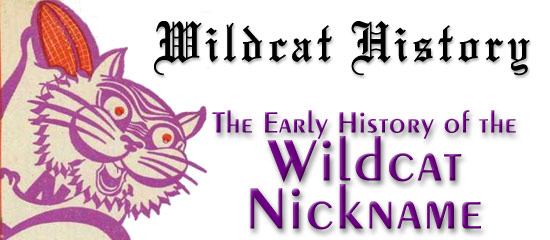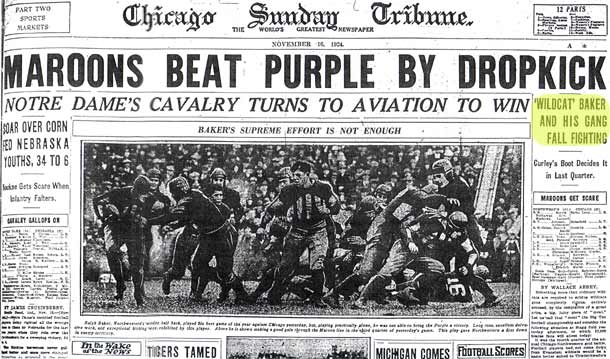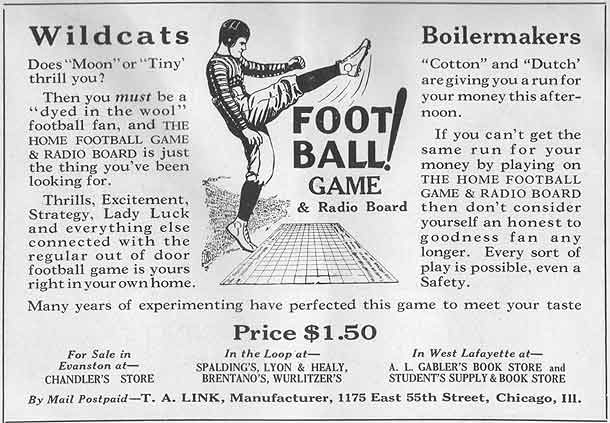|
|
|
Wildcat History Page
Posted
1/22/12
|
|
|
|
 |
|
|


The
origin of Northwestern's nickname, Wildcats, is well-known. The
name came from Wallace Abbey's famous 1924 Chicago Tribune article
covering NU's close loss to the University of Chicago. The team
appreciated Abbey's description of Northwestern as having played like
wildcats, and eventually made it their nickname and mascot.
Eventually, yes-- but when?
Until recently, it was assumed that Northwestern became "The Wildcats"
soon after Abbey's column appeared. Northwestern, in its recent
football media guides and programs, simply stated "from that day [the 1924 NU vs.
Chicago game] on, all Northwestern athletic teams have borne the
nickname of 'Wildcats.'"
However, at the end of 2011 the athletic department changed the
story. The
copy provided for the 2011 Texas Bowl program included this new
passage: "The football team didn't become the Wildcats until the 1930s,
when they adopted that name from a newspaper article that ran a decade
earlier." This new version of the Wildcat history also appears on
Northwestern's university website.
So, is this correct? Just when did Northwestern (and others)
begin calling its teams "Wildcats?"
The answer, it turns out, is that NU began using Wildcats
almost immediately after Abbey's original column, just as NU had
claimed in its earlier programs and guides. The Wildcat nickname
was unoffical, but so was
the Purple nickname that preceeded the Wildcats.
Starting
in the 1890s, Northwestern's football team had been nicknamed "the
Purple." By the early 1920s students began looking for
another nickname, one that would lend itself to a mascot for the
team. The university was also searching for a mascot, one that
might bolster school spirit.
In 1923, inspired by the new Chicago
Bears football team, the school introduced a new bear mascot, called
Furpaw. Furpaw, a live bear cub from the Lincoln Park Zoo, made appearances
at the team's games during the '23 season. Unfortunately, NU had
a losing season, the students wanted to find a different mascot, and
Furpaw was returned to the zoo.
The Purple had been in a slump, but Coach Glen Thistlethwaite's efforts
at rebuilding the team in 1923 were about to pay off.
Thistlethwaite was bringing in top-flight talent, including Ralph
"Moon" Baker (a transfer halfback from Illinois). Late in 1924,
the team was 4-2, but faced Chicago and Notre Dame, the two best teams
in the nation, to close the season.
|

Furpaw (wearing a Northwestern sweater) performs
at Northwestern Field [Syllabus]
|
The Maroon was expected to
trounce Northwestern, but the Purple held its own, keeping the game
scoreless until Chicago made a late score. Chicago won, 3-0, but
NU's performance was stunning, and it led to Abbey's column:

Something
more than ordinary wildcats are required to subdue wildcats gone
completely vicious, entirely aroused, by the temptation of a great
prize, a big, juicy piece of "meat." Let us call that "meat" the
Big Ten football championship and consider the following situation at
Stagg Field yesterday afternoon, to which 32,000 hoarse fans will
attest today:
It was the fourth
quarter of the annual Chicago-Northwestern grid battle. Football
players had not come down from Evanston: wildcats would be a name
better suited to Thistlethwaite's boys. Baker was there, and he
was the chief wildcat giving his supreme effort.
Stagg's boys, his
pride, the eleven that had tied Illinois a week ago, were unable to
score. Once they had been on the 9 yard line and had been stopped
stone dead by a Purple wall of wildcats. . . .
NU
followed up that gritty performance by hanging close with Notre Dame,
before bowing, 13 to 6. NU hosted the game at "the Grant Park
Bowl," the very first football game at Soldier Field. Notre Dame
had, perhaps, the most legendary team in the Irish's entire history,
featuring the original Four Horsemen. But the Purple gave Notre
Dame the fight of the year.
Before the end of the 1924 season, the team was still called the Purple in
the media, but the Wildcat description had already stuck: the very next
edition of the school yearbook, The Syllabus, contained this mention of
the '24 team: "'Wildcats' was the name given to the Northwestern
players by a newspaper writer for their great stand. All of the
Purple players showed high power on the offense, and wildcat
determination on the defense."
The next edition of the Syllabus was even more explicit, dropping the
"Purple" nickname from most references to the team, and describing how
"70,000 spectators saw the Wildcats out-smart and out-play Michigan to
a well-deserved 3-2 victory" in 1925.
The Chicago Tribune had also begun switching from Purple to Wildcats by
the 1925 season, referring to NU captain Tim Lowry as "skipper of the
Wildcats."
And Northwestern cheerleaders had begun, in 1925-- less than one year
after Abbey's column appeared-- to use the "Wildcat Cheer" during
football games:
S-S-S-S-S
Y-e-o-w!!
WILDCATS!!!
There is also ample evidence that the school, by 1925, was using the
Wildcats nickname for teams beside the football squad. The 1925 Syllabus,
referring to the men's basketball season in 1924-'25, stated, "In the
closing half [of the NU - Chicago season finale] the Wildcats were
determined not to lose this game by any fluke such as happened in the
Chicago - N.U. football game. They were bound to win, and win
they did by a 17-16 count."
By the 1926 season, the transformation to Wildcats was complete. Most
references in the media were about the Wildcats, and NUMB was
performing Donald Robertson's new NU fight song, "Wild Cats," on the field. The 1926 Syllabus
proclaimed, "The Wildcat Spirit of Northwestern is an Institution--
it's here to stay." And NU was referring to its players as
Wildcats in its game programs.
Even advertisers by 1926 were referring to the team as the Wildcats:

Print advertisement for Football! Game and Radio Board, 1926.
"Moon" refers to Ralph "Moon" Baker, "Tiny" to Leland "Tiny" Lewis
And the first graphic representations of the NU Wildcat began appearing around the same time...
...such
as this 1927 program cover from the NU vs. Indiana game at Dyche Stadium.
It was also in 1927 that NU first gave the Wildcat a name: "Quacky"
(referring to the university motto, "Quæcumque sunt vera").
The early depictions of the NU Wildcat, such as the one NU used in 1927, were more realistic than
cartoonish, and that continued with the Wildcat version that was being
used by 1933:
Also
in 1933, Northwestern joined up with an ad firm to come up with a
standard image to represent the Wildcat, and NU also settled on
"Willie" as the Wildcat's name. Starting
in 1937, the NU Wildcat, Willie, was drawn
in the more familiar cartoon fashion shown at the top of this page.
Willie the costumed mascot did not prowl the NU sidelines until 1947, but it is
clear that the Northwestern sports teams, and the rest of the school,
were actively (if unofficially) using the Wildcat nickname just weeks-- not years-- after
1924 and the fateful season that Wallace Abbey first bestowed it on the
Purple.
|


|
|
|

